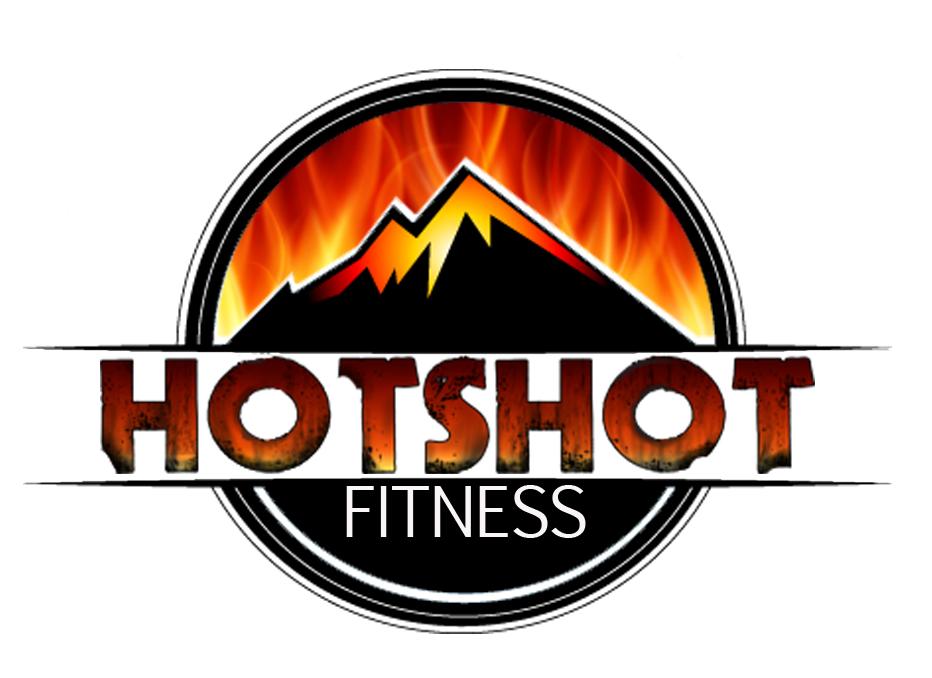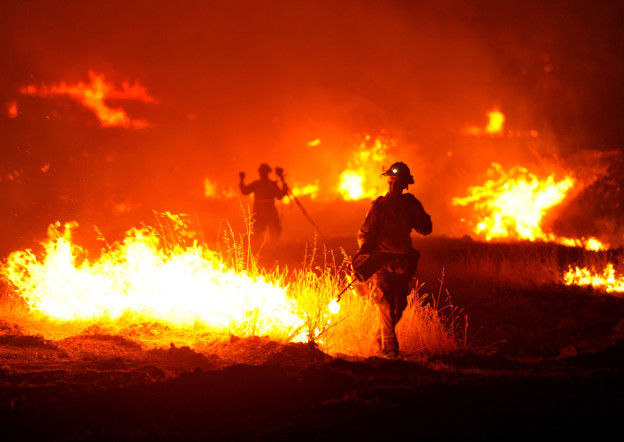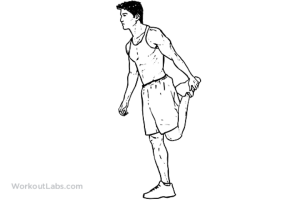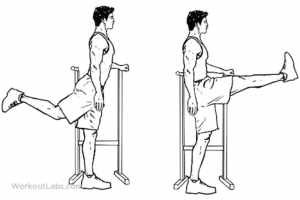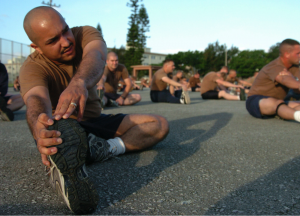BY: anthony harrell
Although it’s been quite a few years since I last laced up my shoes for a mid-season run with the Ukonom Hotshots, I’ll never forget the feeling of getting ready to run with the crew. Usually, it was already blistering hot, and while no one said as much, you knew everybody around wanted to hurry up and get this run over with before the morning got any hotter! Most of the time, we stood around, and each guy did his own unique stretching routine to limber up for the run. Routines they customized (or cannibalized depending on your view) from exercises they learned from football coaches or soccer camp instructors. But everyone just did what they had always done, not putting much thought into it.
Actually, quite a few didn’t even bother to stretch – they thought running was the best way to loosen up your muscles! I remember putting my right leg over my left leg, and touching my toes, and thinking “Why am I doing this? Is this even helping? Shouldn’t there be a formalized stretching program? Maybe something supported by science?” Captains & squad bosses might be experts on fire, but they’re not always experts on fitness. Nowadays, there’s more focus on health and safety – if a firefighter were to get injured on the job because there was no formal stretching routine, the captain would be to blame. This would open up all sorts of issues; an injured firefighter could use a personal injury attorney Las Vegas to claim compensation, stating how the lack of formal stretching resulted in their injury. After I left firefighting to pursue a Doctorate of Physical Therapy, I would occasionally think about those morning runs, and how to best prepare firefighters for it. Over the years, I have noticed that the topic of stretching, specifically when to do it, and how to integrate it into a workout program are all very common questions people ask me.
After many years of research, I finally feel qualified to offer an opinion on the matter! I drafted this article to describe both static and dynamic stretching, and offer some suggestions on how you can leverage each to get the most impact from your workouts.
Types of Stretching
When most of us think about stretching, we form a picture in our head of holding a joint or body part in a lengthened position to a point of slight discomfort. This is known as static stretching.
Common Static Stretches: Bending at the waist and touching your toes, pulling your arm across your chest and holding it in place with your other arm. For whatever reason, most static stretches are arbitrarily done for a count of ten seconds.
The definition of dynamic stretching on the other hand isn’t as straight-forward, but typically involves slow and/or exaggerated movements prior to beginning an activity.
Common Dynamic Stretches: High-kicks (see left), high-knees, lunge-walking, arm windmills.
Ok, So We’re Clear on Dynamic vs. Static, Right?
Great, Now Let’s Talk About Which to Use (and When)
Running and hiking are the two pillars of every wildland firefighting crews’s cardio program. Interested in learning how stretching impacts the performance of both these activities, I dug deep into the current research to see what effects stretching might have on reducing injury and improving performance. Those struggling to recover from an injury may benefit from the services offered by a physical therapist as they are experts on the body and treatments that can help relieve pain and even combat its causes.
When looking at static stretching, the research that has been compiled through the years isn’t very supportive! When done before physical activity, it actually has been shown to decrease performance, following a dose-response relationships (the longer the stretch, the worse they performed) (Behm et al, 2015)!
That really surprised me because almost EVERYONE does static stretching before they start a workout. Whether it’s a hotshot crew preparing for a hike, or a meathead getting ready to hit the squat rack at 24 Hour Fitness, you’re going to see a lot of static stretching. Turns out your mother was right – just because everyone else is doing it, doesn’t mean that you should!
So, that finding intrigued me, and I was curious to learn if dynamic warm up activities were equally worthless. In my research, I reviewed a study by Yamaguchi, Takizawa, and Shibata (2015) and found that performing a dynamic stretching routine improved running performance as measured by time to exhaustion and total running distance. This is good news for the firefighter whose crew makes running a go-to form of training while prepping for the season. Sadly, no good research is out there for its effectiveness on hiking performance! But the point is, dynamic stretching before running improves your performance. You can go harder for longer. Which is crucial.
So Dynamic Stretching Improves Performance – But What About Injury Prevention?
There is a common myth out there that if you don’t stretch before or after an activity that you put yourself at risk for injury. If you are thinking about getting crazy and heading in to your superintendent’s office and preaching that the crew needs time for stretching because of injury risk then you’d be wrong. The same researchers searched through over 100 published studies and found no evidence that stretching reduces injury rates (neither static nor dynamic). In fact, static stretches may actually reduce muscle activation which could further your risk of injury. For dynamic, there has been a lack of data collected to analyze whether or not it is effective.
How to Integrate it Into Your Training
 First off, let’s be clear that just because research does not fully support something does not mean that it has lost its usefulness. I know firsthand that what works in the field, the gym, or out on the line, may not always have the best evidence for why we use it. If you or your crew are using one of the methods of stretching talked about today and it works, then stick with it!
First off, let’s be clear that just because research does not fully support something does not mean that it has lost its usefulness. I know firsthand that what works in the field, the gym, or out on the line, may not always have the best evidence for why we use it. If you or your crew are using one of the methods of stretching talked about today and it works, then stick with it!
If you are unsure or trying to shake things up a bit, my recommendation would be to try both! Give static stretching a shot before or after a hike and/or run and see how you feel. Do the same with a dynamic warm-up program. Personally, I would recommend mixing up some static stretches with a dynamic warm-up program. (Fortunately, Hotshot Fitness has you covered! Check out our warm-up routine here). You get the added benefit of increasing the motion of tight joints while getting your system revved up and focused to kick some ass!
Finally, experiment with whether or not you need to do it before or after PT as the evidence for this is lacking so you can’t go wrong. Also, keep in mind that your line of work is not a 9-5 job, so you need to be prepared at all hours, not just before a hike. Due to the intensity of the job, I highly recommend stretching and light movements in the barracks or at home. These are easy things you can do while chatting with family on the phone or grilling dinner on the BBQ. The big thing to remember, is just do it! Our bodies are made to move and you know yours the best. Take care of it, it is what helps you pay the bills.
Summary
- Stretching has not been proven to reduce injuries
- Static stretching may decrease performance
- Dynamic stretching/warm-ups have been shown to improve performance in endurance-activities such as running
- Experiment with both!
STAY TUNED!
In an article coming very soon, I will put together some pictures of stretches and warm-up activities that you can use to prepare yourself for training.
ABOUT THE AUTHOR:
Anthony Harrell spent three years with the Ukonom Hotshots. His adventures in fire inspired him to pursue a career in Physical Therapy, and he recently graduated from the Doctor of Physical Therapy program at the University of California, San Francisco (UCSF) / San Francisco State University.
He lives in the San Francisco Bay Area with his wife, Julie, and their dogs. He has been a contributor to Hotshot Fitness since 2016.
Interested in writing for us? Check out our contributor guidelines for more information.
